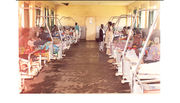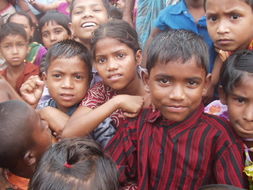Human Development and Education
Human Development
"The basic purpose of development is to enlarge people's choices. In principle, these choices can be infinite and can change over time. People often value achievements that do not show up at all, or not immediately, in income or growth figures: greater access to knowledge, better nutrition and health services, more secure livelihoods, security against crime and physical violence, satisfying leisure hours, political and cultural freedoms and sense of participation in community activities. The objective of development is to create an enabling environment for people to enjoy long, healthy and creative lives."
Domains of human development
- Physical domain
- It has to do with bodily and biological growth or maturation. The growth process involves changes in people’s bodies and the way in which they use their bodies.
- Cognitive domain
- It includes everything to do with knowledge and human ability to know like perception, thought, language memory, intelligence, problem solving, academic progress and learning.
- Psychological domain
- The “psycho” part of psychosocial domain relates to people emotions and their personalities; the “social” refers to their relationship with themselves, their parents or children, their peer group and the world around them.
- Conative domain
- A person’s conative domain includes things like motivation, striving, ambition choices and decision making. It relates to people’s will or inner drive to achieve a goal.
- Moral domain
- Moral domain is a key aspect of a person. It relates to morality, religion, values, attitudes and norms.
Factors that influence human development
1. Genetic factors Children inherit certain genes from their parents, and these genes determine things like the person’s gender, blood group, colour of eyes, age they reach sexual maturity. They can also affect things like personality, interest, intelligence and so on.
2. Constitutional factors It deals with a person’s physical state. Let us say for instance; a person personality can change radically after the onset of a serious disorder like depression, migraine or incontinence. “Physique influences a person’s general development. These influences are particularly noticeable in the case of exceptional characteristics, for example, excessively stout,thin, tall or short people.” Kretschmer and Sheldon (in Louw, Gerdes & Meyer 1990:26)
3. Environment factors A distinction is made between physical and social environment. The main psysical factors are things like climate, an adequate supply of oxygen, toxic gases in the atmosphere, an adequate food supply, temperature and overpopulation. Social environmental factors include social contact with people through communication such as education, social conversation, reading matter, radio and television.
4. Personal factors The fourth set of factors that influences human development is personal factors. It includes things like personality, self-concept, disposition, motivation, enthusiasm and stamina. These factors can either intensify or reduce the influence of genetic, constitutional or environmental factors. For instance blindness; whereas one person may withdraw from society because of the handicap, another may overcome handicap courage, self-confidence and enthusiasm and still live a rich, full life.
Prenatal development, neonatal development and infancy
Prenatal phase
The prenatal period lasts from conception to birth. This is a vital important development phase, during which enormous growth and development occur. The prenatal environment and various other factors can hamper the growth and development of the foetus so much that the child’s physical and mental health will be seriously affected after birth. Factors influencing the wellbeing of the foetus are: the mother’s age and eating habits, imprudent and excessive use of medication, narcotics and alcohol, contact with certain infectious diseases during the first three month of pregnancy, incompatibility between her blood group and her baby’s and the emotional state of the mother.
Neonatal phase
Neonatal phase starts from birth and ends when the baby is about four weeks old. During this phase babies are called neonates. Babies are tiny creatures, extremely fragile and vulnerable. They are most dependent on adult care. They have to be fed, comforted, cleaned and protected. Despite their helplessness and dependence they are not totally unprepared for life outside the womb. On the contrary, at birth babies possess abilities to control their new environment. They are able to eat, expel bodily waste and regulate their body temperature.
Infancy
The first two years of a child’s life are a period of rapid change. Apart from tremendous bodily growth, there is rapid cognitive development and it is a critical period in children’s psychosocial development.
- Physical development- Babies grow extremely fast. Their height and mass increase, their bodily proportion change, their muscles and skeletons grow and their teeth and nervous system develop. From the day of birth infants are engaged in an exciting journey of discovery. Their exploration not only expands the limits of their world of experience and meaning, but also helps them to come to grips with things in the world. Thus they need some muscle control.
- Cognitive development- Infants are in the sensorimotor phase of development. At first their cognitive activities consist of reflex actions, but they gradually more voluntary and the child’s own will starts playing a greater role. One of the main developmental tasks during this phase is the ability to understand object permanence. By understanding object permanence, infants learn that an object continues to exist even when it is out of sight. Another important task is to learn imitate things in the environment, consciously or unconsciously. Language development is a key part of cognitive development includes cooing, babbling, sound imitation and gestures.
- Psychosocial development- Infancy is characterized by infants’ emotional attachment to their environment. When babies show their feelings like love, anger, pleasure, frustration and anxiety, they do so with abandon. As they grow older, their intellect starts taking over increasingly and begins to control their emotional life. The most striking feature of infants’ social development is that their relations with other people are dynamic. Their play too is dynamic. Whereas they used to play alone, they now start socializing with playmates and the first signs of social play and fantasy play emerge.
Early childhood (about 2-6 years)
Change continues in early childhood, but less rapidly than during infancy. During this phase children become physically more capable, intellectually more able and their social life becomes more complex. Their command of language improves dramatically and they soon learn the rules of their mother tongue and secrets of communication.
- Physical development- Although children inherit their growth tendencies from their parents, there is a definite correlation between nutrition, growth and general health. Physical growth is influences by such factors: quality of nutrition, emotional factors, genetic inheritance, stress, emotional privation or neglect. Mass increase is largely as a result of muscle and bone development. In this phase, the bone hardens and become stronger and from the age of four muscles develops rapidly.
- Cognitive development- In the phase of cognitive development, children start to socialize and explore the world by means of communication. Reasoning and egocentrism are probably the main features of cognitive development. Children are more and more inclined to imagine, fantasise and observe and their language acquisition enables them to verbalise their thoughts and to question things. With growing experiences, their egocentrism gradually decreases.
The preoperational phase is a phase pf preconceptual and intuitive thought and has the following characteristics: 1.Children live through their imagination 2.Objects are use differently from the way it is used. For example a broom becomes a horse. 3.The children language has some characteristics: -egocentrism: they talk to themselves or about themselves -repetition: they like to repeat new words or phrases -experimentation: young children like to experiment with new words and ways of talking -imitation: they consciously imitate sound
- Psychosocial development- When children leave infancy behind and enter early childhood, they are faced with two opposing poles. They are able to do more things-and they want to do increasingly more. At the same time they learn that while some of their actions are socially accepted, others are strongly condemned. So they faces the choice of doing what they would like to do or doing what their parents and important others in their lives approve. The emotions that children experience during this phase form a crucial subsection of their psychosocial development. Emotions like anger, fear, anxiety, jealousy, happiness and love feature prominently.
- Conative development- Children conative development is characterized by growing independence from their parents and independence decision making. These feelings of self-control, autonomy, initiative and guilt often cause friction between them and those in charge of them. They want to do everything themselves and want to see, touch and try everything in the environment for themselves. They will also do anything to get their own way and have difficulty taking no for an answer.
- Moral development- In early childhood, the emphasis in children’s moral development is mainly on external control and the concrete, direct consequences of actions. They are not born with a conscience, but only with the potential to learn to judge morally, ethically and religiously. It is up to parents and child-minders to pass on, through the example they set, the values, norms and morals of the society and cultural community in which children live.
Middle childhood (about 6-12 years)
Many of us remember little about our infancy and early childhood. But from middle childhood onwards most people remember quite a lot about their lives: their emotions, relationships are sometimes also how difficult it was to adapt to school and learn to read and write.- Physical development- The beginning of middle childhood is a period of slow steady growth; follow by a phase of more rapid growth just before puberty. The physical development of children however varies greatly from one child to the next. While some children reach sexual maturity by the middle of middle children, others on.ly mature sexual much later during adolescence. Moreover the gross motor muscles are better developed. This increased strength, coordination, and muscle control enables them to use their bodies confidently.
- Cognitive development- Most researches and theorists agree that there are some major changes in children’s thought patterns and learning styles round the age of seven. An outstanding feature of this phase is that children develop and use a coherent cognitive system. As a result, they are able to relate the present to the past and to link together different aspects of the world.
- Psychosocial development- Middle childhood also brings major changes in children’s personalities and in their emotional and social domains. There is an increase in children’s emotional expression such as manifestation of fear, anger and aggression, jealousy, joy and happiness.
- Conative development- In this phase the guidance of parents, child-minders, teachers and community workers is invaluable. Their help and guidance teach children not only to take sensible decisions, but also to carry out these decisions and take the consequences.
- Moral development- Although societies differ in their interpretations of right and wrong, there are some virtues that most people strive for. These virtues include honesty, conscientiousness, considerateness and friendliness.
Adolescence (about 12-18 years)
Although it is difficult to tie the adolescent phase to a chronological age, it is generally accepted that it starts somewhere between the age of 11 and 13 and ends between the ages of 17 and 22. Adolescents were regarded as people characterized by inner stress and confusion .modern researches no longer hold this view. They say that adolescence is a period of enormous change in all domains of development and these changes can cause children serious social and emotional problems.
- Physical development
- Cognitive development
- Psychosocial development
- Conative development
- Moral development

